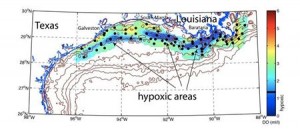http://healthygulf.org/201108041709/blog/healthy-waters-/-dead-zone/epa-denies-petition-to-curb-river-pollution-while-gulf-dead-zone-rages#.Tjxv1kDXo2c.facebook
Blog – Healthy Waters / Dead Zone
Thursday, 04 August 2011 14:35
New Orleans, LA—EPA has denied a petition to implement a clean-up plan for an aquatic Dead Zone in the Gulf of Mexico, despite heavy economic losses to the U.S. fishing industry and continued research that shows the Dead Zone has doubled in size since 1985. This week, scientists from the Louisiana Universities Marine Consortium completed their annual measurement of the Gulf Dead Zone, which measured 6,765 square miles and is larger than the state of Connecticut. Members of The Mississippi River Collaborative had petitioned the EPA to set numeric limits on the discharge of pollutants that feed the Dead Zone. However, last week EPA declined to take responsibility for setting regulations that would address the problem of lackluster and hodge-podge individual states’ water pollution regulation.
The Dead Zone in the Gulf of Mexico is an area where there is not enough oxygen in the water to support marine life. It forms every summer, caused by high levels of nitrogen and phosphorus pollution draining from the Mississippi River watershed. The pollution stimulates excessive growth of algae, or blooms. When the dying algae decays it uses up most of the oxygen in the water, which chokes marine life. The pollution comes from chemical fertilizer escaping farm fields, sewage treatment plant discharges, and polluted runoff from cities. These sources of pollution are along the entire length of the Mississippi River.
“Just days before the announcement that the measured size of the Dead Zone is larger-than-average, the EPA declined to take actions to limit Dead Zone-causing pollution and to implement a clean-up plan,” said Matt Rota, Science and Water Policy Director for the Gulf Restoration Network. “The Dead Zone is detrimental to Gulf sea life and the coastal residents’ way of life, and yet EPA continues to rely on the states to do things they have failed to do for well over a decade.”
Despite the fact that the Dead Zone has ballooned over the past thirty years, EPA denied the petition, filed in 2008 by members of the Mississippi River Collaborative, which asked for immediate action to set numeric limits on Dead Zone-causing pollution in the Mississippi River and Gulf, as well as create an enforceable clean-up plan for the Dead Zone.
The petition showed that EPA has neglected its responsibility under the federal Clean Water Act to limit pollution in the Mississippi River and the Gulf of Mexico. Through the petition, the Mississippi River Collaborative also showed that the Dead Zone will continue to grow unless EPA sets numeric standards for nitrogen and phosphorus pollution and requires all states in the river basin to meet those standards. Efforts now in Congress to cut funds for Farm Bill conservation programs—designed to prevent both cropland erosion and fertilizer run-off pollution—will exacerbate the pollution in the river and the Dead Zone.
Not only does the Dead Zone threaten the $2.8 billion Gulf fishing industry, nitrogen and phosphorus pollution cause environmental problems throughout the entire Mississippi River Basin. For example, toxic algae blooms result in fish kills, the death of livestock and pets, and damage to drinking water supplies. The Mississippi River Collaborative believes that because of the basin-wide implications of nitrogen and phosphorus pollution, it is the EPA’s responsibility to take a leadership role in preventing further pollution.
“It’s distressing that the EPA will allow the decade of delay by the states along the Mississippi River to continue,” said Kris Sigford, Water Quality Director for the Minnesota Center for Environmental Advocacy. “So there is effectively no one to tackle the pollution that causes green, gunky lakes, toxic algae blooms, unsafe drinking water supplies and the wipeout of marine life in the Gulf.”
The EPA called on states in 1998 to adopt specific limits on nitrogen and phosphorus pollution, threatening to enact its own limits if states had not complied by 2003. Every state along the Mississippi River has ignored that and other deadlines set by EPA, but so far, the federal government has failed to supply urgently needed protections. As a result, inland water pollution problems have multiplied while the Dead Zone makes its annual appearance—each time bringing with it damage to the coastal residents and their livelihood.
Special thanks to Gulf Restoration Network.
